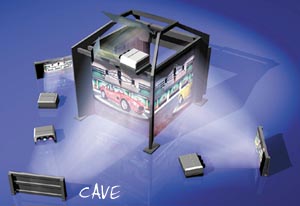~~ Virtual Reality ~~
what is virtual reality,
Tags: virtual reality gamesvirtual reality technologyvirtual reality in entertainmentvirtual reality environmentvirtual reality devices


Presently there are numerous different types of VR systems, but most can be classified into one of the following three categories; Desktop VR, Video Mapping VR, and Immersive VR.
The computer must be powerful enough to render three-dimensional images in real-time or the experience will not be a complete one.
Computers this fast do not exist at the present time, but with the power of computers doubling every 18 months, it may be possible in the near future. (Stevens 1994)

In the past, computing power has doubled approximately every 18 months, a trend that is known as Moore’s Law. (Webopedia 2004) If this is the case then we should have a computer powerful enough to run immersive VR programs in our own homes by the year 2037. With the advancements in nanotechnology and quantum computing (where computers mimic the human brain’s processes) this figure could be expected to grow exponentially.
Today VR technology is still in its infancy, and there are damaging flaws. Graphics, no matter how impressive, are not lifelike. Time lags are far too long. Optic and auditory hardware are not 100% realistic. Users can walk into walls or pick up an object without feeling a thing. The equipment is still far too expensive for everyday use. But each and every one of these drawbacks is the subject of intense research and work; the problems are being overcome, and VR is poised for its major breakthrough. (Sherman and Judkins 1992)

The chart below briefly outlines some of the major arguments for and against societies inevitable submission to a virtual reality culture.
Will we be cut off from reality living in a computer-generated fantasy?
Or will we be more involved with others having adopted a new method of social interaction?
Does the future contain a VR world driven by commercialism and produces an offspring of techno-addicts and sociopaths?
Or can we imagine a future driven by researchers and educators, those who desire the greatest common good over the almighty dollar?
There seems to be little doubt among thinkers of the social impact of VR, as much as television has, and the Internet is, regarding playing its own part in the power games of our time. But like everything, humankind will adapt by necessity. From health to education, torture to war, and art to government; virtual reality will increasingly make its presence felt and change the way we perceive things. ‘As time goes on, so the technology will progress, and move further away from its original aims, rather like gunpowder. virtual reality started in the abstract, and then moved on to war; perhaps ultimately it will bring peace.’ (Sherman and Judkins 1992)
what is virtual reality,
Tags: virtual reality gamesvirtual reality technologyvirtual reality in entertainmentvirtual reality environmentvirtual reality devices
Searches related to virtual reality
[Virtual Reality] is not just a tool; it is at once technology, medium, and engine of social relations. It not only structures social relations, it is the space within which the relations occur and the tool that individuals use to enter that space. It is more than the context within which social relations occur, for it is commented on and imaginatively constructed by symbolic processes initiated and maintained by individuals and groups. (Mayer 1999)

The idea of Virtual Reality began well before the advent of the computer, but in dealing only with the VR in the sense in which we know it, all its history has occurred over the past 40 years.
| ||||||||||||||||||||||||||||||||||||||||||||||

Presently there are numerous different types of VR systems, but most can be classified into one of the following three categories; Desktop VR, Video Mapping VR, and Immersive VR.
Desktop VR (Window on a World) | Video Mapping VR | Immersive VR |
| Desktop VR is when a computer user views a virtual environment through one or more computer screens. A user can then interact with that environment, but is not immersed in it. All of the mastheads on this website are from Desktop VR environments. | Video Mapping VR uses cameras to project an image of the user into the computer program, thus creating a 2D computer character. Although fully immersed in the environment, it is difficult to interact with the user’s surroundings. | Immersive VR uses a HMD to project video directly in front of the user’s eyes, plays audio directly into the user’s ears, and can track the whereabouts of the user’s head. Then a dataglove (or datasuit) is used to track movements of the user’s body and then duplicate them in the virtual environment. When the user cannot distinguish between what is real and what is not, then immersive VR has succeeded. |
To run the most basic VR system one must have the following:• one or more powerful computers | 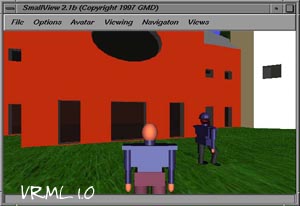 |
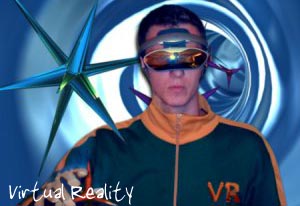 | By using various sensors and input devices users can use their own movement to interact with the virtual environment. Each time the sensor detects a change, the entire computer system (the reality engine) generates a new set of graphics, appropriate to that change. For a system to be recognizably ‘real’ the computer must be able to ‘sample’ the sensors about sixty times per second. This gives real-time changes (apparently instantaneous, but really with the shortest time lag possible). (Sherman and Judkins 1992) |

| 1999 | 10% of the world's computing power was non-human |
| 2029 | 99% of the world’s computing capacity will be non-human |
 | When we use the human brain as the standard for computing ‘real-life’ scenarios we can estimate when VR systems can do the same. The human brain can perform 20 quadrillion calculations per second, while the most powerful supercomputer in the world today, The Earth Simulator in Yokohama, Japan, can perform 35.86 trillion calculations per second. (www.cnn.com 2004) |

 | Whether virtual reality will have positive or negative implications on the social structure is debatable, but one thing is certain – VR will play an increasingly important role in public and private life as we move towards the future. The idea of virtual reality faces humankind with a completely new phenomenon, what are the practical consequences of inhabiting a different reality? (Sherman and Judkins 1992) |
Pros | Cons |
| • VR is imaginably more personal than electronic mail or instant messaging, or even a letter or a telephone call • VR is a great social leveler, it may find a common ground across differences in age, culture, and linguistic orientation (Biocca and Levy 1995) • people will be drawn together by similar interests instead of purely by geographic location (Biocca and Levy 1995) • communication will be both challenging and rewarding, more effective and productive, and thus more enjoyable (Biocca and Levy 1995) • a tremendous opportunity for every 'connected' person to find his or her field and/or discipline(Biocca and Levy 1995) • after using a medium that provides total freedom of expression face-to-face communication may be found to be too confining (Cartwright 1994) | • an inescapable aspect of social life is the formation and maintenance of interpersonal relationships (Biocca and Levy 1995) • interaction ought not be substituted for community (Mayer 1999) • separates the 'haves' from the 'have-nots', a technology of Information Age Industrialized nations • VR will provide a communication environment in which the dangers of deception and the benefits of creativity are amplified beyond the levels that humans currently experience in their interpersonal interactions. (Biocca and Levy 1995) • could lead to low self-esteem, feelings of worthlessness and insignificance, even self-destructive acts (Cartwright 1994) |
Or will we be more involved with others having adopted a new method of social interaction?
Does the future contain a VR world driven by commercialism and produces an offspring of techno-addicts and sociopaths?
Or can we imagine a future driven by researchers and educators, those who desire the greatest common good over the almighty dollar?
| Sherman and Judkins have written an incredible book in regards to the projected future ramifications of a VR society, and you can purchase it by following this link: Glimpses of Heaven, Visions of Hell: Virtual Reality and its Implications. As the debate over the effects on society of VR, perhaps it is important to look back to VR visionary Ivan Sutherland and his statement from 1965. “Why not create computers that were designed to accommodate themselves to the wayhumans worked?” | 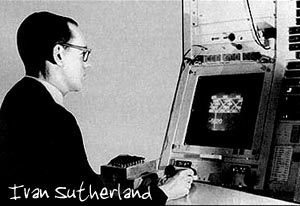 |
| In the future we will only be limited by our imagination regarding the uses of virtual reality. Thus it is neither good not bad, but rather what we make of it. “It could be a lifesaving godsend, a groundbreaking educational tool, a means of becoming out best selves. Or, it could be a mindless, energy-sapping diversion, an off-ramp to electronic isolation, a playground for immortality. Chances are, it will be all of these things.” (Kershner 1995) | 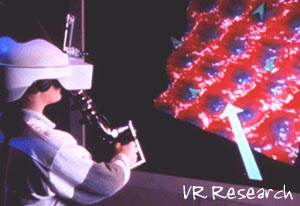 |
This site was published for Communication Studies 380 at the University of Calgary, March 26, 2004
